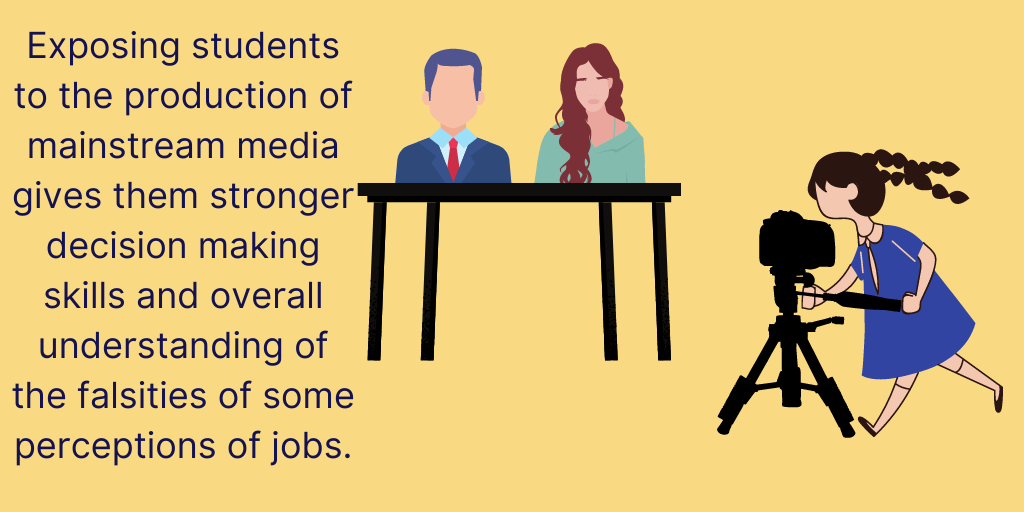Media programs have been emerging in schools everywhere with a rising interest in technology integration. Teachers have been getting very creative with ways to make tech integration educational, immersive, and fun. Bruce Reicher, a technology teacher at Upper Saddle River Public Schools, is a great example of a teacher who has years of experience getting creative with their school’s K-12 media program. In a recent conversation, we sat down with Bruce to find out why K-12 media programs are so important, especially during distance learning.
Bruce’s Background with K-12 Media Programs
In 1985 Bruce graduated from the University of Hartford with a degree in TV and Radio Production. During his time at Hartford, Bruce worked at a radio station covering the UMass football and basketball games.
At this point, Bruce never even thought that teaching TV and radio production would be his future career path. He shared a Steve Jobs quote during our conversation to describe how he never expected to become a teacher but when he looks back he can connect the dots to how he began his journey.
“You can’t connect the dots looking forward; you can only connect them looking backward. So you have to trust that the dots will somehow connect in your future.”
Somewhere down the road, Bruce found himself using his radio and TV production degree to teach K-12 students how to run their own radio and TV shows. He shared that this process is actually quite similar to producing an actual TV show, and reminiscent of some of the productions he did in college.
For the last 20 years, Bruce and his students have put on a live TV show at 8:03 every morning. More recently, Bruce has been working on a book called Scripted: An Educator’s Guide to Media in the Classroom. Available everywhere on August 11th, this book is all about how creating media in the classroom is a loose concept.
The punchline? A huge budget or heavily produced program is unnecessary. Bruce explained that inside the book you will be able to find a list of resources and ideas to use in your classroom. A collaborative effort from 3 experienced educators filled with first-hand knowledge of experimenting with media programs.
Distance Learning Impact on Media Programs
Producing a show takes a lot of work and for students to gain the full experience they have to be present in class to learn. Distance learning has put a strain on k-12 media programs because of the hands-on environment the tv show production provides.
The format of the show, production of the show, and responsibilities of students completely changed since distance learning began. Instead of the usual everyday show, Bruce’s students are putting on a show once a week and he explains how amazing the content produced has been.
With the extra time, students have had opportunities to experiment with other tools on the internet and put in extra work for the production of the show. Bruce is hoping that student interest will increase in the future and more students will have the opportunity to be a part of the show after distance learning.
The Learning LiftOff says, “applying media literacy to this discipline encourages learners to decipher the truthfulness of web advertisements and recognize when biased organizations sponsor news articles.” Exposing students to the production of mainstream media gives them stronger decision-making skills and an overall understanding of the falsities of some perceptions of jobs.

During distance learning, students are able to continue to grow their learning skills even outside of the classroom with the k-12 media programs. The downtime students have during distance learning is often used in exploration for more of an understanding of the media programs when these programs are implemented. This gives students a productive and beneficial way to spend their time while out of the classroom.
K-12 media programs give students exposure to what a future career in technology could possibly consist of. Students gain re-created real-life experience in a field that is rapidly growing into all industries. Media programs are a great way to create an immersive technology integration experience. Make learning fun for your students and find ways to teach applicable tech lessons.
Listen to the full conversation with Bruce Reicher on our Tackling Tech Podcast!
This week Brett talks with Bruce Reicher, a middle school teacher who teaches television production, coding, and G Suite in New Jersey. Bruce and two other tech teachers co-wrote a book with ideas for teaching media production available in August. Bruce shares tips on building a PLN (professional development network) and his background in sports broadcasting.
Start teaching confidently with Dyknow for free!
Latest blog articles

Dyknow 2021 Year In Review
In addition to web browser updates and bug fixes, Dyknow released several major product updates, new features and enhancements. Check out Dyknow’s 2021 Year in Review!

The Classroom Management Tool that’s Rated #1 in Satisfaction on G2
K-12 Administrators across the world trust G2 as the #1 platform to find, research, and choose EdTech tools that solve the most pressing problems their teachers are experiencing. In G2's Fall 2021 Reports, Dyknow was once again rated #1 in overall Satisfaction out of...

Bringing Diversity and EdTech to the English Classroom
On this episode of Tackling Tech, Tierra Leustig interviews Scott Bayer about being an anti-racist teacher, diversifying reading lists, creating inclusive learning environments, and leveraging ed-tech in non-technical ELA classrooms. Scott Bayer is a High School...

